Affiliate links on Android Authority may earn us a commission. Learn more.
What's ARM's role in the Internet of Things?
Published onJune 16, 2014
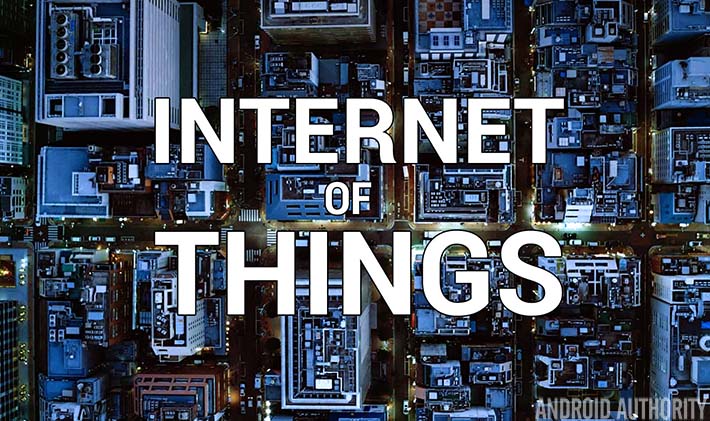
ARM may be well known for spearheading processor development for our favourite mobile devices, but the company also offers a wide range of processors for many other applications. Wearables look set to be the next big range of smart devices, but increasingly we’re seeing other pieces of technology make use of microprocessors and wireless communication technologies.
While the fully connected world of the Internet of Things (IoT) is still a way away, an increasing number of devices are being built which can communicate with each other, either via wireless connections, like Bluetooth, or through the World Wide Web.
IoT, a market set to explode
Current technological trends all point towards an ever more seamlessly connected world, and for that to happen we need cost effective, low power, and highly connected devices.
One of the biggest driving forces behind the internet of things is the falling costs of processor production. Microprocessors, and other important pieces of technology, are now affordable enough were we can use them in almost every product. Combined with improvements in low energy wireless technologies and the prevalence of the internet in the modern world, it’s becoming easier and easier to have all of these smart devices talk to each other.
The MIT Technology Review estimates that close to 28 billion devices will be connected to the internet by 2020, with almost half of these devices being “things”, rather than smartphones or PCs.
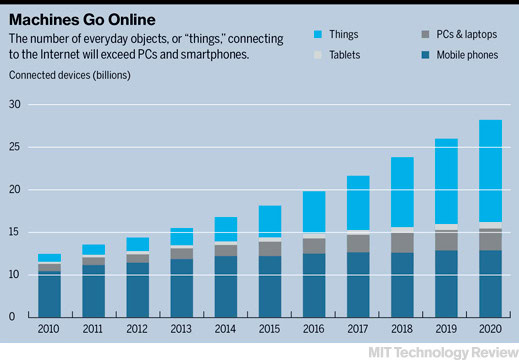
In 2013 alone, over 10 billion ARM microprocessors and microcontrollers were shipped across a range of industries, many of which are already connected to the Internet. Although many of these processors are found in common mobile devices, other market segments, including automation, security, and even street lighting, are all steadily seeing growth in microcontroller shipments.
Some good examples of the useful implications of well-connected devices come from NEST. Although NEST only has a small line-up of smart connected products available at the moment, idea’s like Auto-Away for its Thermostat, which turns the temperature down when you’re out of the house, and phone alerts if you’re smoke alarm goes off, are definitely pointing in the right direction.
the Internet of Things is not one market, but many different market segments
But that’s just the start. Over here in the UK, a dedicated network for the Internet of Things will begin rolling out next year. British telecommunications company Arqiva announced plans earlier this month to build and maintain a national network for IoT using ‘ultra-narrowband’ technology, which will allow for communication over long distances between a range of devices. The network will begin rolling out in 10 of the UK’s largest cities come May 2015, and is set expand to the rest of the country in the following months and years.
Humble beginnings
As mentioned earlier, price and availability play a much more crucial role in IoT technologies than high performance processors. We can actually trace back relevant pieces of technology to some of the very first ground breaking microprocessors developed after the creation of my all-time world changing invention – the transistor.
Although the first transistors arrived in the late 1950’s and the first MOFSET integrated circuits appeared in the 1960’s, it wasn’t until the 1971 that one of the first commercially available microprocessor went on sale, the 4-bit Intel 4004, which was composed of 2,300 transistors etched on a tiny processor that cost around $60.
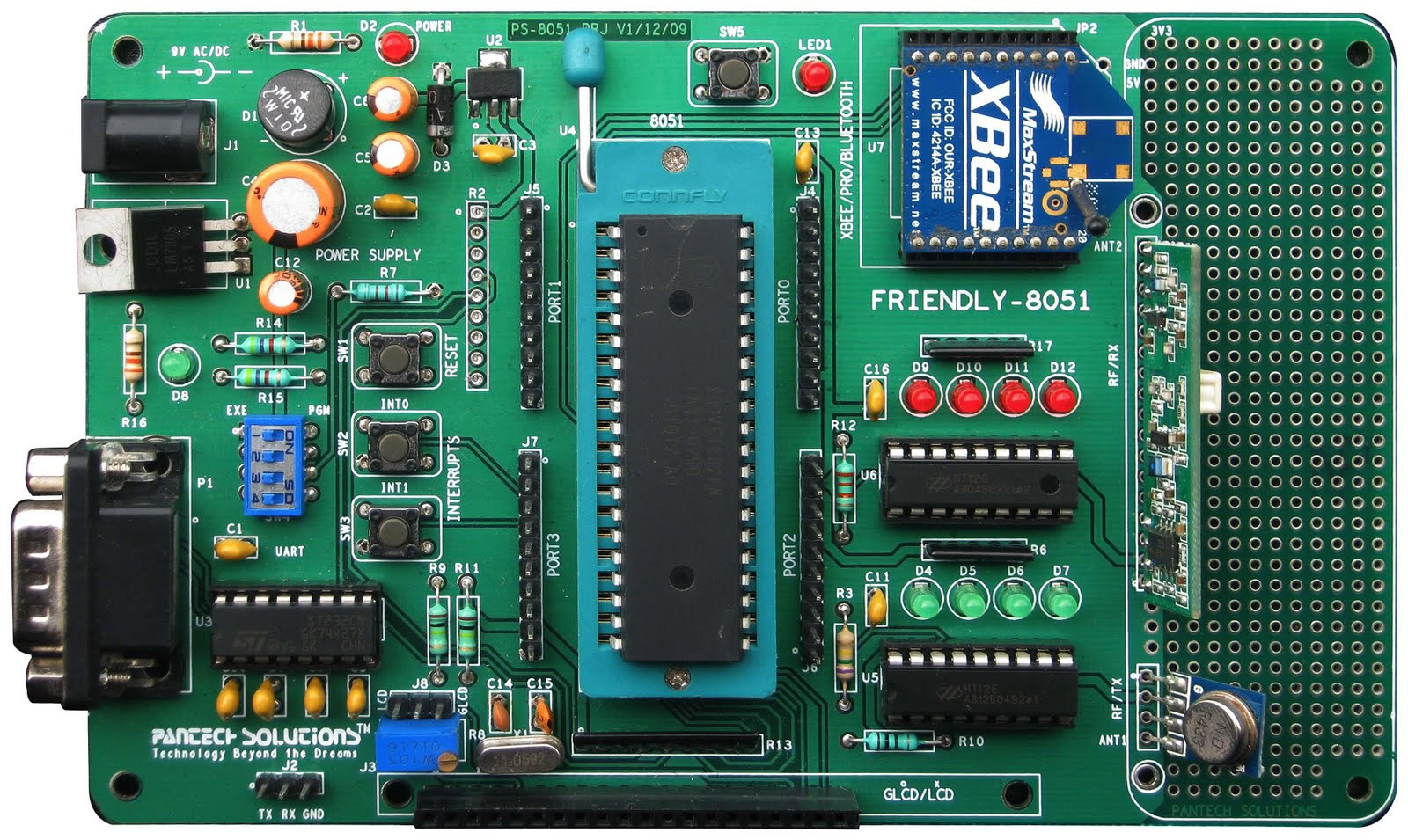
Just a year later, Intel produced the first 8-bit 8008 processor, followed by the first general purpose microprocessor, the 8080, in 1974. From there, Intel would go on to produce its first single chip microcontroller, which housed not only a CPU but also a fixed amount of RAM and ROM on a single chip. Faster, modern revisions of these original designs still find use in many electronic devices to this day, and can cost as little as $1.
The importance of microcontrollers may not seem obviously relevant for larger devices that require larger powerful CPUs that can connect to components externally, but in small, low power, and low cost devices, microcontrollers are indispensable. IoT devices tend to make use of highly integrated components, they don’t need expandable storage for example, which is why having an efficient all-in-one microcontroller makes a lot of sense.
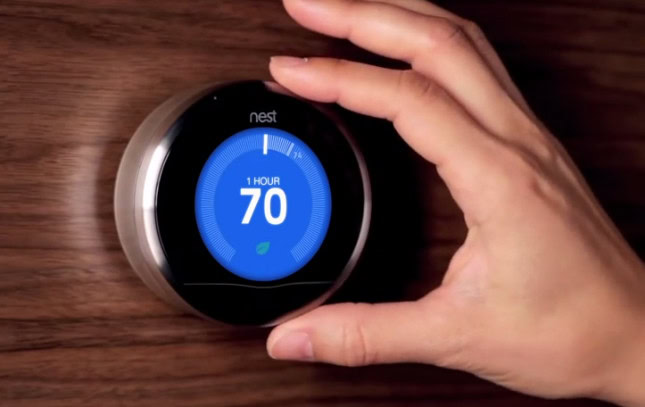
Today’s low power ARM processors, which we will look at in a minute, are also designed to work in microcontroller configurations, as this suits the small form factor of small devices. However, to meet the more unique needs of connected devices, ARM’s designs have been tweaked for improved security, enhanced connectivity, and flexible amounts of processing power, giving IoT developers all the tools they need to build small computers from a single package.
Although we are more familiar with powerhouse multi-core 32-bit and 64-bit processors these days, the humble microprocessor and it’s more evolved Cortex-M cousins are on the front lines when comes to devices with small form factor and low power requirements.
ARM’s take on the Internet of Things
As you probably know, ARM doesn’t manufacturer any complete microcontrollers itself, the final designs are left to other manufacturers who license core designs from ARM. Even so, the company has invested plenty of development into microcontroller designs, as well as the processor core designs that we are more used to hearing about. ARM’s Cortex-M series has currently been licensed to over 40 partners, including big players like STMicroelectronics and Texas Instruments.
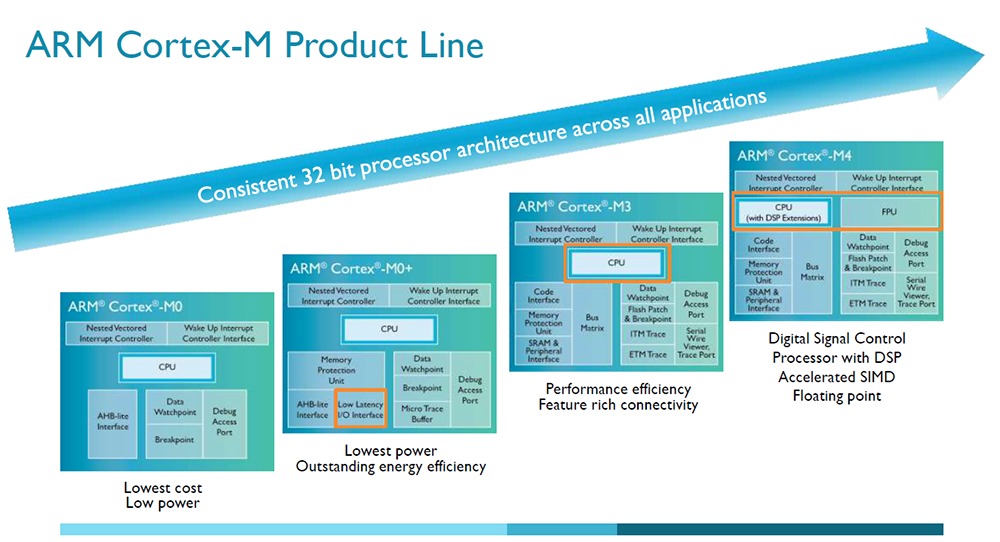
As we have mentioned a few times in the past, ARM’s Cortex-M series is the company’s leading low power processor line-up. The range includes core designs suitable for moderately powerful connected devices, such as smartwatches and other wearables, right down to very low power designs, the Cortex-M0 and M0+, which are primarily used in nonetheless essential behind the scenes processing tasks. All of these cores are intended for microcontroller use, and ARM has made its own improvements to traditional designs to help power a wider range of devices.
In 2013 alone over 10 billion ARM microprocessors and micro-controllers were shipped
If you are familiar with the first batch of wearables on the market, you will probably have noticed that they are all powered by ARM based processors. The balanced Cortex-M3 has proven particularly popular in smartwatch devices which require some level of user input, while more passive fitness tracker bands are powered by the even smaller Cortex-M0 and M0+ designs.
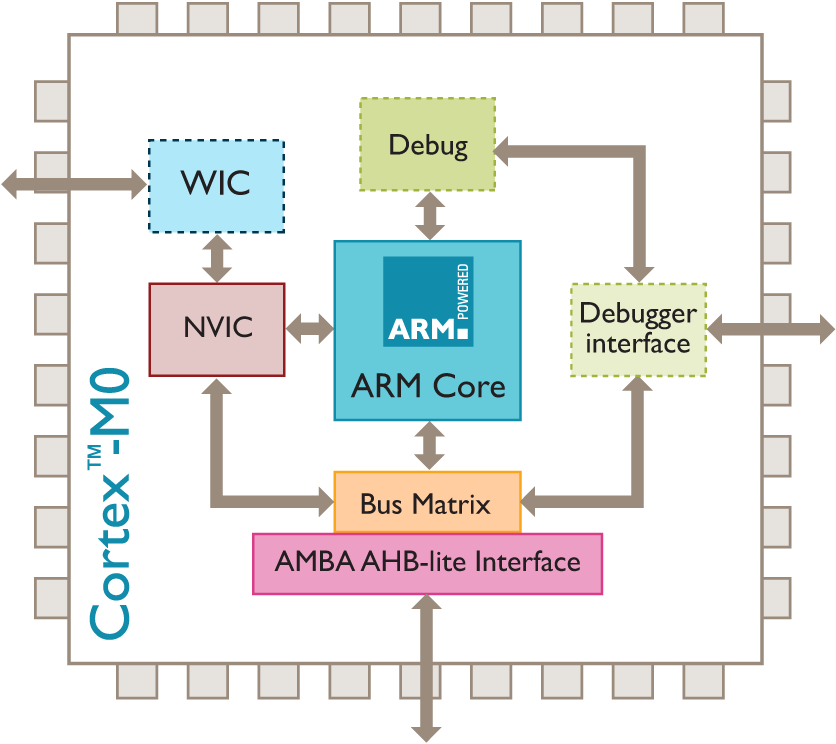
The Cortex-M0 has been developed well beyond the student’s favourite 8051, even though both might appear quite suitable for the low power requirements of the internet of things. For a start, the Cortex-M0 is based on ARM’s experience with higher performance 32-bit architectures, while a large portion of other microprocessors are still based on the older 8-bit design. This has wide ranging implications for developers, processing speeds, and cryptography.
ARM’s 32-bit design benefits from retaining full compatibility with more advanced coding languages like C, where an 8-bit device would struggle. The Cortex-M range make use of ARM’s Thumb2 instruction set, rather than the full 32-bit ARM set that we see in our Cortex-A powered smartphones, which provides a subset of the most commonly used 32-bit ARM instructions which have been compressed down to just 56 instructions for improved efficiency. On execution, these 16-bit instructions are decompressed back into full 32-bit instructions in real time, without performance loss. The superior code density of this instruction set allows developers to get more done with the smaller amounts of memory found in small form factor Cortex-M microprocessors, many of which come with just 258Kb memory or less .
Security, Internet standards and power consumption are the three most important design considerations today.
Importantly, the Cortex-M0 retains tool and binary upwards compatibility with the more feature rich Cortex-M and Cortex-A processors, which is a bonus for developers looking to bridge the gap with other mobile technologies. Software developers can compile programs for Thumb2 which will then also work on ARM’s Cortex A range of processors.
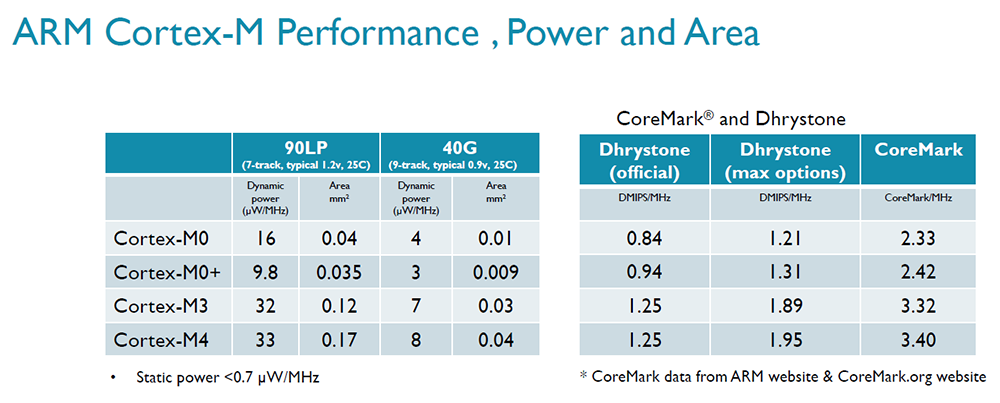
As you can see from the table above, ARM has focused heavily on improving the energy efficiency of its processors for low power devices. This is hugely important for always-on technologies and devices which demand long battery lives. More sophisticated smart IoT devices won’t be built from single inputs and processors, but will most likely require a number of low power microprocessors with which to perform various tasks for a wide range of sensors and inputs. ARM calls this technique “sensor fusion”, where various low-power always-on sensors are used to enhance user interactions.
“The Internet of Things is the collection of smart, sensor-enabled physical objects, and the networks, servers and services that interact with them” – ARM Cortex-M Marketing Manager Diya Soubra
Sticking with microprocessor capabilities, ARM’s 32-bit design also has some additional benefits for security measures than 8 or 16-bit designs. ARM’s architecture can support strong asymmetric cryptography and protocols on all of its 32-bit processors, right down to the lowest power Cortex-M0 chips. Such techniques would be considerably slower on other low power 8 or 16 bit architectures. Considering that the Internet of Things requires extensive connectivity via the web, strong encryption and security features will no doubt become an essential part of the industry as more and more devices go online.
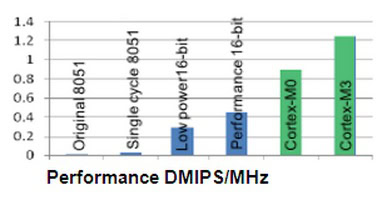
Finally, ARM’s range of low power processors are designed with full support for low power connectivity features, including Bluetooth Low Energy (BLE), IEEE 802.15 and Z-wave. As you can imagine, these are particularly important for the world of connected devices.
Investment in new platforms
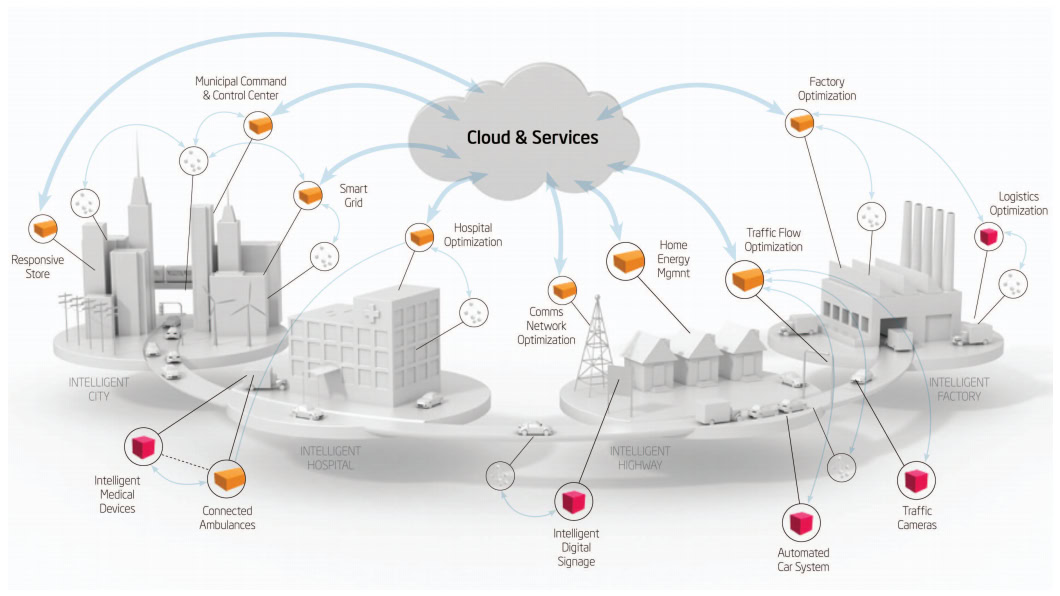
As we mentioned before with wearables, ARM’s mbed developer platform is helping developers to explore and expand the range of IoT products available. As well as a wealth of hardware development resources for developers, the company also has its own range of development boards and platforms for its Cortex-M line-up, in much the same was as Intel has its own boards for developers.
ARM’s development platform also extends to software creation, and includes its Cortex-M SDK and online cloud development platform, as well as compilers for its Thumb2 instruction set and online C/C++ integrated development environment. ARM also actively maintains a GCC source branch for its Thumb2 compilers, which is openly available for integration into other third party toolchains and for direct use.
We strongly believe that a healthy software ecosystem is critical for an industry to take off.
Furthermore, ARM recently purchased Finnish IoT start-up company Sensinode. Sensinode software is designed to allow low-power devices to communicate over the internet using the IPv6 protocol which will be crucial for the future for IoT communication. ARM has since integrated Sensinode’s technology into its mbed developer platform, which now plays a central role in device to cloud communications and ARM’s device management software.
ARM is also continuing to build on the support that it currently offers through its partner Linaro, which provides open source software for ARM systems, along with conventional Java and Android development platforms, which may end up playing a pivotal role in how we communicate with smart IoT devices in the future. Developers looking for more information on ARM’s embedded technologies should check out the mbed HDK and SDK, and explore the vast mbed community.
Investments in new platforms from developers and products designers is going to be the real driving force behind innovation in the IoT market. In the future world of the Internet of Things, if you look closely, you’ll probably find ARM processors powering even more devices.